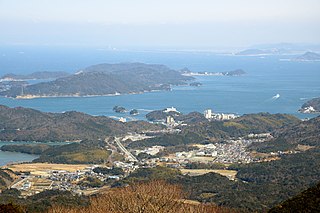
Mie Prefecture is a prefecture of Japan located in the Kansai region of Honshu. Mie Prefecture has a population of 1,781,948 and has a geographic area of 5,774 square kilometres (2,229 sq mi). Mie Prefecture borders Gifu Prefecture to the north, Shiga Prefecture and Kyoto Prefecture to the northwest, Nara Prefecture to the west, Wakayama Prefecture to the southwest, and Aichi Prefecture to the east.

Tahara is a city located in Aichi Prefecture, Japan. As of 1 October 2019, the city had an estimated population of 60,206 in 22,576 households, and a population density of 315 persons per km². The total area of the city is 191.12 square kilometres (73.79 sq mi).

Kuwana is a city located in Mie Prefecture, Japan.

Toba is a city located in Mie Prefecture, Japan.

Wakasa is a town located in Yazu District, Tottori Prefecture, Japan.
Tado was a town located in Kuwana District, Mie Prefecture, Japan.
Nagashima was a town located in Kuwana District, Mie Prefecture, Japan.

Kuwana is a district located in Mie Prefecture, Japan.

Asahi is a town located in Mie Prefecture, Japan. As of November 2012, the town had an estimated population of 9,941 and a population density of 1660 persons per km². The total area was 5.99 km².

Kawagoe is a town located in Mie Prefecture, Japan. As of June 1, 2019, the town had an estimated population of 14,999 and a population density of 1718 persons per km². The total area was 8.73 km².

Kaizu is a city located in Gifu, Japan. As of 1 April 2018, the city had an estimated population of 34,960, and a population density of 310 persons per km2, in 12,167 households. The total area of the city was 112.03 square kilometres (43.26 sq mi). Most of the city is located at sea level and is well known for levees surrounding the area.

Ichinohe is a town located in Iwate Prefecture, Japan. As of 1 April 2020, the town had an estimated population of 12,053, and a population density of 40 persons per km² in 5645 households. The total area of the town is 300.03 square kilometres (115.84 sq mi).

Aga is a town located in Niigata Prefecture, Japan. As of 1 July 2019, the town had an estimated population of 10,327, and a population density of 10.8 persons per km2. The total area of the town is 952.89 square kilometres (367.91 sq mi).

Fujimino is a city located in Saitama Prefecture, Japan. As of 1 February 2016, the city had an estimated population of 111,218, and a population density of 7600 persons per km². Its total area is 14.64 square kilometres (5.65 sq mi).

Noto is a town located in Hōsu District, Ishikawa Prefecture, Japan. As of 1 February 2018, the town had an estimated population of 17,840 in 7689 households, and a population density of 65 persons per km2, in 2542 households. The total area of the town was 273.27 square kilometres (105.51 sq mi).

The Tado Festival is a Japanese festival that takes place every year during Japan's Golden Week on May 4 and 5 at Tado Shrine in the city of Kuwana, Mie Prefecture.

The Yōrō Mountains are a mountain range straddling the border between Gifu and Mie prefectures in Japan. They form part of the western border of the Nōbi Plain.

Sugashima (菅島) is an inhabited island located in Ise Bay off the east coast of central Honshu, Japan. It is administered as part of the city of Toba in Mie Prefecture. It is the second largest of the outlying islands of Toba. Historically, it was noted for its Ama divers.

The Jōmon period is the time in Japanese prehistory, traditionally dated between c. 14,000–300 BCE, recently refined to about 1000 BCE, during which Japan was inhabited by a hunter-gatherer culture, which reached a considerable degree of sedentism and cultural complexity. The name "cord-marked" was first applied by the American zoologist and orientalist Edward S. Morse, who discovered sherds of pottery in 1877 and subsequently translated it into Japanese as Jōmon. The pottery style characteristic of the first phases of Jōmon culture was decorated by impressing cords into the surface of wet clay and is generally accepted to be among the oldest in the world.
















